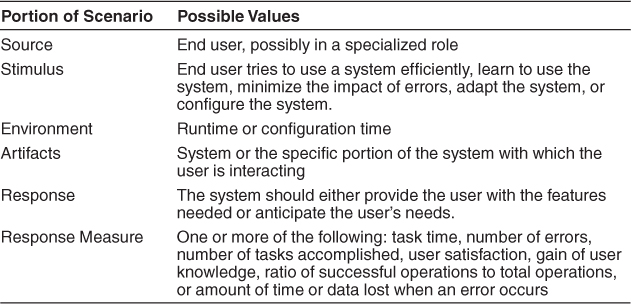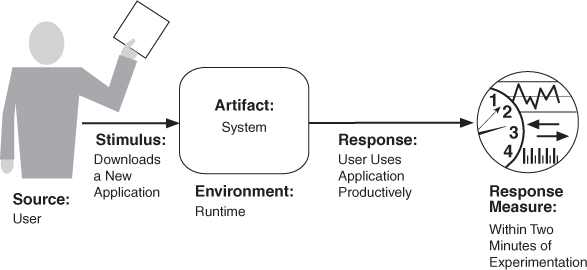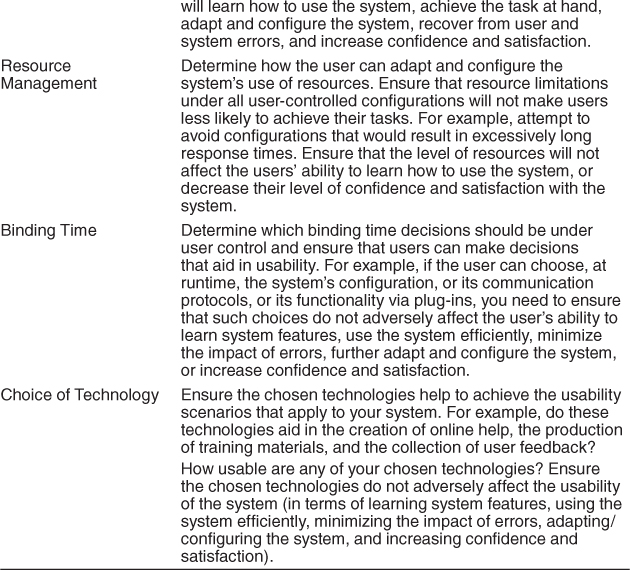11. Usability
Any darn fool can make something complex; it takes a genius to make something simple.
—Albert Einstein
Usability is concerned with how easy it is for the user to accomplish a desired task and the kind of user support the system provides. Over the years, a focus on usability has shown itself to be one of the cheapest and easiest ways to improve a system’s quality (or more precisely, the user’s perception of quality).
Usability comprises the following areas:
• Learning system features. If the user is unfamiliar with a particular system or a particular aspect of it, what can the system do to make the task of learning easier? This might include providing help features.
• Using a system efficiently. What can the system do to make the user more efficient in its operation? This might include the ability for the user to redirect the system after issuing a command. For example, the user may wish to suspend one task, perform several operations, and then resume that task.
• Minimizing the impact of errors. What can the system do so that a user error has minimal impact? For example, the user may wish to cancel a command issued incorrectly.
• Adapting the system to user needs. How can the user (or the system itself) adapt to make the user’s task easier? For example, the system may automatically fill in URLs based on a user’s past entries.
• Increasing confidence and satisfaction. What does the system do to give the user confidence that the correct action is being taken? For example, providing feedback that indicates that the system is performing a long-running task and the extent to which the task is completed will increase the user’s confidence in the system.
11.1. Usability General Scenario
The portions of the usability general scenarios are these:
• Source of stimulus. The end user (who may be in a specialized role, such as a system or network administrator) is always the source of the stimulus for usability.
• Stimulus. The stimulus is that the end user wishes to use a system efficiently, learn to use the system, minimize the impact of errors, adapt the system, or configure the system.
• Environment. The user actions with which usability is concerned always occur at runtime or at system configuration time.
• Artifact. The artifact is the system or the specific portion of the system with which the user is interacting.
• Response. The system should either provide the user with the features needed or anticipate the user’s needs.
• Response measure. The response is measured by task time, number of errors, number of tasks accomplished, user satisfaction, gain of user knowledge, ratio of successful operations to total operations, or amount of time or data lost when an error occurs.
Table 11.1 enumerates the elements of the general scenario that characterize usability.
Table 11.1. Usability General Scenario

Figure 11.1 gives an example of a concrete usability scenario that you could generate using Table 11.1: The user downloads a new application and is using it productively after two minutes of experimentation.
Figure 11.1. Sample concrete usability scenario
11.2. Tactics for Usability
Recall that usability is concerned with how easy it is for the user to accomplish a desired task, as well as the kind of support the system provides to the user. Researchers in human-computer interaction have used the terms user initiative, system initiative, and mixed initiative to describe which of the human-computer pair takes the initiative in performing certain actions and how the interaction proceeds. Usability scenarios can combine initiatives from both perspectives. For example, when canceling a command, the user issues a cancel—user initiative—and the system responds. During the cancel, however, the system may put up a progress indicator—system initiative. Thus, cancel may demonstrate mixed initiative. We use this distinction between user and system initiative to discuss the tactics that the architect uses to achieve the various scenarios.
Figure 11.2 shows the goal of the set of runtime usability tactics.
Figure 11.2. The goal of runtime usability tactics
There is a connection between the achievement of usability and modifiability. The user interface design process consists of generating and then testing a user interface design. Deficiencies in the design are corrected and the process repeats. If the user interface has already been constructed as a portion of the system, then the system must be modified to reflect the latest design. Hence the connection with modifiability. This connection has resulted in standard patterns to support user interface design (see sidebar).
Support User Initiative
Once a system is executing, usability is enhanced by giving the user feedback as to what the system is doing and by allowing the user to make appropriate responses. For example, the tactics described next—cancel, undo, pause/resume, and aggregate—support the user in either correcting errors or being more efficient.
The architect designs a response for user initiative by enumerating and allocating the responsibilities of the system to respond to the user command. Here are some common examples of user initiative:
• Cancel. When the user issues a cancel command, the system must be listening for it (thus, there is the responsibility to have a constant listener that is not blocked by the actions of whatever is being canceled); the command being canceled must be terminated; any resources being used by the canceled command must be freed; and components that are collaborating with the canceled command must be informed so that they can also take appropriate action.
• Undo. To support the ability to undo, the system must maintain a sufficient amount of information about system state so that an earlier state may be restored, at the user’s request. Such a record may be in the form of state “snapshots”—for example, checkpoints—or as a set of reversible operations. Not all operations can be easily reversed: for example, changing all occurrences of the letter “a” to the letter “b” in a document cannot be reversed by changing all instances of “b” to “a”, because some of those instances of “b” may have existed prior to the original change. In such a case the system must maintain a more elaborate record of the change. Of course, some operations, such as ringing a bell, cannot be undone.
• Pause/resume. When a user has initiated a long-running operation—say, downloading a large file or set of files from a server—it is often useful to provide the ability to pause and resume the operation. Effectively pausing a long-running operation requires the ability to temporarily free resources so that they may be reallocated to other tasks.
• Aggregate. When a user is performing repetitive operations, or operations that affect a large number of objects in the same way, it is useful to provide the ability to aggregate the lower-level objects into a single group, so that the operation may be applied to the group, thus freeing the user from the drudgery (and potential for mistakes) of doing the same operation repeatedly. For example, aggregate all of the objects in a slide and change the text to 14-point font.
Support System Initiative
When the system takes the initiative, it must rely on a model of the user, the task being undertaken by the user, or the system state itself. Each model requires various types of input to accomplish its initiative. The support system initiative tactics are those that identify the models the system uses to predict either its own behavior or the user’s intention. Encapsulating this information will make it easier for it to be tailored or modified. Tailoring and modification can be either dynamically based on past user behavior or offline during development. These tactics are the following:
• Maintain task model. The task model is used to determine context so the system can have some idea of what the user is attempting and provide assistance. For example, knowing that sentences start with capital letters would allow an application to correct a lowercase letter in that position.
• Maintain user model. This model explicitly represents the user’s knowledge of the system, the user’s behavior in terms of expected response time, and other aspects specific to a user or a class of users. For example, maintaining a user model allows the system to pace mouse selection so that not all of the document is selected when scrolling is required. Or a model can control the amount of assistance and suggestions automatically provided to a user. A special case of this tactic is commonly found in user interface customization, wherein a user can explicitly modify the system’s user model.
• Maintain system model. Here the system maintains an explicit model of itself. This is used to determine expected system behavior so that appropriate feedback can be given to the user. A common manifestation of a system model is a progress bar that predicts the time needed to complete the current activity.
Figure 11.3 shows a summary of the tactics to achieve usability.
Figure 11.3. Usability tactics
11.3. A Design Checklist for Usability
Table 11.2 is a checklist to support the design and analysis process for usability.
Table 11.2. Checklist to Support the Design and Analysis Process for Usability

11.4. Summary
Architectural support for usability involves both allowing the user to take the initiative—in circumstances such as canceling a long-running command or undoing a completed command—and aggregating data and commands.
To be able to predict user or system responses, the system must keep an explicit model of the user, the system, and the task.
There is a strong relationship between supporting the user interface design process and supporting modifiability; this relation is promoted by patterns that enforce separation of the user interface from the rest of the system, such as the MVC pattern.
11.5. For Further Reading
Claire Marie Karat has investigated the relation between usability and business advantage [Karat 94].
Jakob Nielsen has also written extensively on this topic, including a calculation on the ROI of usability [Nielsen 08].
Bonnie John and Len Bass have investigated the relation between usability and software architecture. They have enumerated around two dozen usability scenarios that have architectural impact and given associated patterns for these scenarios [Bass 03].
Greg Hartman has defined attentiveness as the ability of the system to support user initiative and allow cancel or pause/resume [Hartman 10].
Some of the patterns for separating the user interface are Arch/Slinky, Seeheim, and PAC. These are discussed in Chapter 8 of Human-Computer Interaction [Dix 04].
11.6. Discussion Questions
1. Write a concrete usability scenario for your automobile that specifies how long it takes you to set your favorite radio stations? Now consider another part of the driver experience and create scenarios that test other aspects of the response measures from the general scenario table.
2. Write a concrete usability scenario for an automatic teller machine. How would your design be modified to satisfy these scenarios?
3. How might usability trade off against security? How might it trade off against performance?
4. Pick a few of your favorite web sites that do similar things, such as social networking or online shopping. Now pick one or two appropriate responses from the usability general scenario (such as “achieve the task at hand”) and a correspondingly appropriate response measure. Using the response and response measure you chose, compare the web sites’ usability.
5. Specify the data model for a four-function calculator that allows undo.
6. Why is it that in so many systems, the cancel button in a dialog box appears to be unresponsive? What architectural principles do you think were ignored in these systems?
7. Why do you think that progress bars frequently behave erratically, moving from 10 to 90 percent in one step and then getting stuck on 90 percent?
8. Research the crash of Air France Flight 296 into the forest at Habsheim, France, on June 26, 1988. The pilots said they were unable to read the digital display of the radio altimeter or hear its audible readout. If they could have, do you believe the crash would have been averted? In this context, discuss the relationship between usability and safety.




